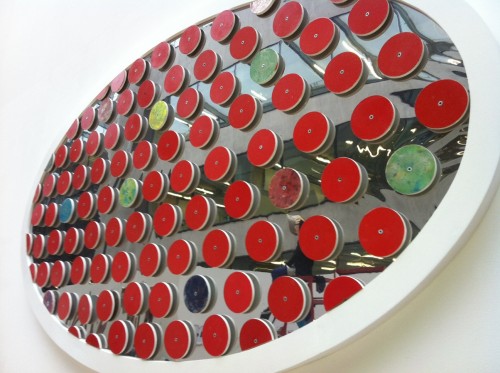By James Dacey

“Parity Series, Far Infrared”. (Courtesy: Mehri Imani, Central Saint Martins)
The worlds of art and science came together yesterday in central London in a celebration of creativity across disciplines. A symposium at Central Saint Martins College of Art and Design was held to recognize the first group of students to complete the Art and Science MA course – the first course of its kind in the UK. Students taking this course are given the chance to explore the “creative relationships between art and science and how to communicate them”.
I popped along to yesterday’s event, which included guest speakers and presentations from some of the students graduating from the course. Among the presenters was Renaissance man Sir Jonathan Miller CBE, who among other things is a medical doctor, comedian, TV presenter, opera director and sculptor. In one of his impeccably timed rants about education systems, Miller talked about the “huge boring dichotomy between art and science” and how it creates artificial divides within the pursuit of knowledge.
Another notable speaker was Arianne Koek, who is in charge of the international arts programme at CERN. Koek has been running programmes in which artists take up residencies at CERN to work in collaboration with particle physicists, which she described in this video interview with Physics World from 2011.
Koek expressed her belief that CERN is the most exciting location in the world in the quest for new knowledge, and she described her vision for artists at the particle-physics lab to be accepted on an equal level with the scientists. “Art and science are both about who, why and where we are in the world,” said Koek. “We are on the threshold of a future [at CERN] where we can go across disciplines.”
In this week’s Facebook poll, we want you to answer the following question.
Is creativity as important in science as it is in art?
Yes
No
Please visit our Facebook page to have your say. As always, feel free to explain your choice by posting a comment either on the Facebook page or below this blog entry.
In last week’s poll we asked you to select the Nobel-prize-winning physics invention that you believe has had the most profound impact on society. The outcome was conclusive, with 75% of people opting for “the transistor”, the discovery of which was honoured in the 1956 prize shared by William Bradford Shockley, John Bardeen and Walter Houser Brattain. The rest of the votes were shared as follows: charged-coupled device (1%); scanning tunnelling microscope (0%); laser (10%); electron microscope (2%); optical fibres (5%); wireless telegraphy (7%); and X-ray crystallography (2%).
The question also led to some interesting comments from our Facebook followers.
“I would say the transistor, but I am going with wireless telegraphy because it immediate impact on the world wars and subsequent events.”
Mike Pletcher
“Of all the moments in history when I might have been born, I consider myself lucky to have arrived about the same time as the transistor.”
Drew Stoddard
“It would be X-ray crystallography since this method helped in completing our understanding of what we know about solids, and laid the base for solid-state physics.”
Sham S Panchal
Thanks for all you participation and we hope to hear from you again in this week’s poll.
Trackback: Blog - physicsworld.com